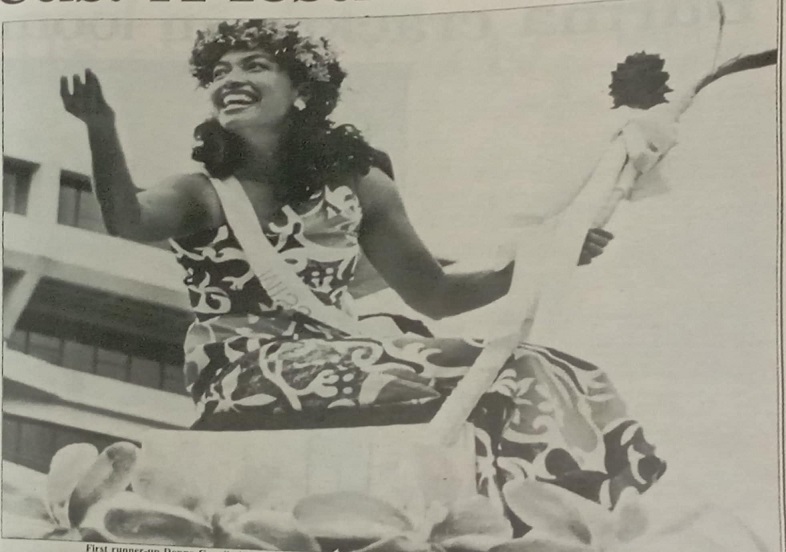The Fiji Times had published an article on August 23, 1998, about how the Hibiscus festival had thrilled the hearts of the people since its inception in 1956, thanks to the effort of the Suva Junior Chamber of Commerce.
The article stated the festival committee, led by president John Butler, should be commended for its hard work and efforts that had become a major revenue earning and was the much anticipated event of the city.
Back then, names such as Hicks, Clarke, Munif, Bish, Fenn, Wendt, Wilson, Gajadhar, Vunibola, Dunn, Sabharwal, White, Penchala, Gucaki, Ah Yuk, Curtis, Higgins, Pickering, Hoefflich, Whiteside, and Bukchup graced the judges’ bench.
Events such as the wheelbarrow race from the Government Buildings to the Town Hall during the day, entertaining music from the Fiji Military Forces outside the Town Hall, an eight o’clock procession to the Town Hall which began from the market, and a colourfully decorated town were then the highlights of the two-day festival.
With free admission, hundreds were unable to get into the Town Hall for the final Hibiscus judging on Friday night, December 14.
In addition to awarding points on physical beauty and personality, entrants were individually engaged in conversation behind the curtain by all the judges and marks given on conversational ability.
The climax of the event was the crowing of the first ever Miss Hibiscus by the Governor’s wife, Lady Garvey, in the fully packed Town Hall.
That was the day 18-year-old Liebling Hoefflich created history in Suva.
Like all the Hibiscus queens since, Miss Hoefflich’s blue eyes turned misty and she hastily fumbled for a handkerchief when Lady Garvey placed the title ribbon around her.
Hoefflich’s prize was a trip to Sydney on Pan American Airways.
Twenty-year-old Susan Curtis, a hostess on White’s Travel Service, a tour-bus industry doing trips around the country, won the prize offered by her own employer.
Lydia Pickering won the third prize while Lois Bish took the fourth.
John Manchester, one of the vice presidents of the festival committee who was acting in place of Mr Butler, said the festival was a great success.
“We know now how to plan next year for a bigger and better show,” Mr Manchester said
And no doubt the butcheries, the supermarket shelves, and our pockets have all felt the effects of the Hibiscus Festival down the years.
Luckily enough in 1998 the “big ma” up there decided not to open the taps for the whole week,
And the hundreds of stall and Ferris wheel owners had their own stories to tell.
Tevita Raiyawa, of Kinoya — who had a barbecue and lovo stall by the road — said businesses were not so good.
“The stalls costs $1000 and only made up to $600 profit per day if business was good. After that we’ll have to minus expenses. It depends on the weather too.”
Mr Raiyawa said it wasn’t fair when illegal vendors sold food and drinks close to the grounds without the council’s consent.
“The council should put a firm foot down on these people because they’re taking some of our business.”
Another grievance was the taps; Mr Raiyawa said that while there were hundreds of stalls, there were only two taps to share — one near the pavilion and the other on the far side of the ground, beside Cakobau Rd near Thurston Gardens.
Mohammed Jabal, a salesman on one of the popcorn and candy floss stalls, said although competition was tough, he enjoyed the spirit of the festival.
Mr Jabal came all the way from Lautoka and paid $8 for the stall and he also had stalls at other festivals like the Sugar, Bula and showcases.
They made deductions of $300 to $400 per day from their takings during the week.
Ferris wheel owner Sham of J S Ali Amusements had four Ferris wheels operating throughout the week.
“It’s been a great week. We’ve had a 99 per cent success rate this year compared to last year,” he said from within his cage-like booth.
“We paid $800 to $1300 for each Ferris wheel and will make around $3000 in profit at the end of the week,” said Mr Sham.
He had done business at 15 Hibiscus Festivals.
Apart from the usual food and sweet stalls, Ferris wheels, children’s joy-rides and blasting music from Communication Fiji’s sound equipment, newcomers included a tattooing van for artificial and permanent tattoos, slow horse rides, and a Christian radio station.
For the young at heart, the Hibiscus Festival was a time to renew friendships or start new ones.
But for the forgotten segment of our population, the birds, mongooses and stray dogs in Suva, it could be the beginning of their festivities.
Especially when the famous old Albert Park would display blotches of garbage left behind after the council’s clean-up.
But the Hibiscus flower itself would bloom for a long time.



